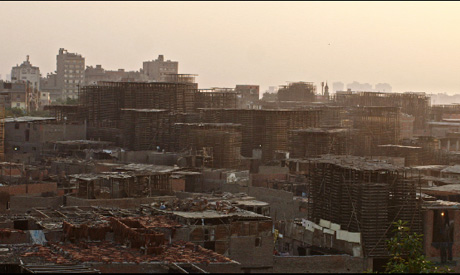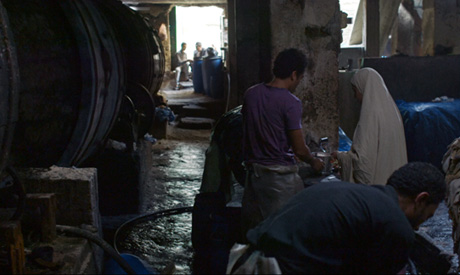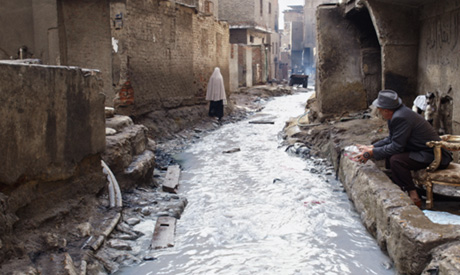Poisonous Roses (Ward Masmum) premiered at the 2018 International Rotterdam Film Festival. Since then, it has been shown in over twenty international film festivals, winning the Best Film Prize at the Tarifa-Tangiers African Film Festival (FCAT) in Spain and the Jury’s Special Prize at the African International Film Festival in Nigeria. A milestone in Egyptian cinema after the 2011 Revolution, the film is a stunning look into the working-class world of the tanneries in Cairo, “a world without hope and without despair” as goes the film’s tagline.
Behind the monumental Magra el-Oyoun wall at the heart of Cairo lies one of the most profitable industries in Egypt: the tanneries. This would seem hard to believe just peering through the openings in the wall, looking onto naked red brick houses and precarious wooden structures where gelatin and leather are left to dry. It becomes even harder to believe after venturing into the tanneries, through its uneven dusty roads covered in industrial waste pouring out of workshops equipped with infernally loud barrels that exude a distinctive acrid stench, and where twenty to thirty thousand workers daily exert themselves in the shadows of the tanneries’ towers.

Figure 1 - A bird's eye view of the tanneries (© Al-Batrik Art Production&Hautlesmains Productions)
And yet, exports from the tanneries are a major reason behind Egypt’s biggest trade partnership in Europe, the billions of euros generated through commerce with Italy, nearly 200 million of which are just in tannery exports. These are the kind of business interests underlying the Italian government’s current relationship with Egypt. This political economic context is not apparent at first in Poisonous Roses, because the film eschews explicit historical references to offer a striking visual account of the daily life of tannery workers.
Only the attentive eye will spot the occasional graffiti in the background – “No to the moving of the tanneries” – which conveys the struggles of tannery workers against a government that has fragilized their livelihood by moving the industry outside Cairo. However, in a context marked by an overload of political talk of the Revolution, the director Ahmad Fawzi Saleh made a conscious choice to show the Egyptian workers behind the headlines, whose plight did not seem to change after the events of 2011.
The film has a simple storyline: Taheya, a toilet cleaner and the main provider in her household, cares for her brother Saqr, who unloads chemically treated skins in a tanning workshop for a living. Every day, Taheya braves the inhospitable roads of the tanneries to bring home-cooked food for her brother at lunchtime. Every night, she takes a long microbus journey to an upscale mall where she cleans until dawn, under the disdainful glances of the mall’s clientele. The tension rises when Saqr expresses his intention to illegally migrate to Italy, while having a nascent but fickle relationship with a young bourgeois doctor, both of which terrify Taheya, and motivate her to do everything to keep Saqr by her side.

Figure 2 - Taheya and Saqr inside a tanning workshop (© Al-Batrik Art Production&Hautlesmains Productions)
The lengths to which Taheya is willing to go could be interpreted, superficially, as the consequence of erotic desire. This interpretation is subtly implied in a scene within the family home, at night, where Taheya first learns about Saqr’s relationship with the doctor. The scene occurs at a moment where the narrative leaves some doubt about the exact relationship between the two characters: is it Saqr’s wife, his lover, his sister? Saqr has his back to Taheya, who is wearing a night gown and combs her wet hair in front of his mirror. Without looking at him, she asks him to distance himself from the Sheikh, his best friend, who encourages him to leave Egypt and whose respiratory struggles brought Saqr to meet the doctor at the hospital. “I’ve met someone,” Saqr answers harshly and laconically.
This intimate miscommunication illustrates the dialogue’s style: sparse, choppy, disconnected, lifeless. The main characters speak little, but their silence is overshadowed by the industrial noises of the tanneries, by the music shouting from loudspeakers and microbuses, by the television jingles promising a deceptive grand prize to desperate callers, by the interminable chatter of workers in the tanning workshops or at the mall. Without a musical soundtrack, the film is overtaken by Cairo’s sound environment, which is as oppressive to the characters as their uninhabitable setting. The tanneries district becomes a character of its own, not just through its physical space, its images, its colors, but also its noises, its rhythms, its almost perceptible smells.
In a later scene, Saqr comes home late at night. He goes to his room without talking to Taheya, who sleeps by the door while waiting for him. She wakes up, her murderous eyes set on him. The handicam’s humming movement follows her to the kitchen and back to the bedroom. This time, with a knife in hand, her message is direct: “I’ll kill her!” Taheya’s mother, a weak character overall, suddenly decides to quell her daughter’s urges by beating her. The scene is awkward, the beating seems uncalled for, yet it contributes to the impression of arbitrary violence inflicted on all characters by their living conditions.
The strength of Taheya’s feelings for Saqr seem unsettling, bordering on the incestuous. How else can we explain that Taheya shares such intimacy with Saqr, coming and going into his bedroom, using his mirror to comb her hair? Why would she feel so jealous about his love interest to the point of threatening him and her physically? Why would she fear being away from him when he migrates or possibly finds a wife? This interpretation is left open to the viewer, but it misses a crucial point: in a working-class neighborhood where nothing is guaranteed, where life is so cheap that all living beings are mired in an industrial wasteland, where living spaces are so tight that there is no real opportunity for privacy, what remains available to Taheya and Saqr is just a form of solidarity.
That this solidarity becomes expressed in the form of caring fraternal love – cooking daily meals, washing and ironing clothes, looking forward to the all-too-brief respite of an evening at the local fair – will not surprise those who have lived under such conditions in Cairo. The visual backbone of the film, in fact, is constituted by drawn-out handheld shots that follow Taheya through her daily activity, often without showing her face, since the image’s affect comes from rote action and not just melodramatic expression. The real tension is not between the siblings, in this sense, but between a crushing capitalist machine eviscerating the lives and souls of workers, and the persistent solidarity – and love – that they manage to grow and nurture against all odds.
The contours of this love are better traced within the Sufi tradition that Fawzi Saleh evokes at times: a brand of Islam which, in some interpretations, equates love of God with a love of the world, insofar as God is indistinguishable from his creation. Taheya and Saqr’s love cannot be understood within the bounds of an individual relationship, as according to a model of bourgeois romantic love, but it must be situated in a world where brother and sister, worker and worker, human and animal coexist to survive. Within the tanneries, the coexistence of hard material conditions and supernatural beliefs is unsurprising in this sense, when horses, goats, dogs, cats, birds, and magicians are all integral to this world’s everyday tapestry.
The camerawork patiently weaves this tapestry through handheld shots going through the city behind Taheya, but also through still shots documenting the leather-making process and inserts on eerie details in the environment: a pipe vomiting waste water, a catfish in a plastic tub, a knife cutting red meat, the rotting cadaver of a horse near the Magra el-Oyoun wall. Life and death intertwine in and around the leather-making process, a cinematic metaphor that Fawzi Saleh has used to good effect in his earlier documentary, Living Skin (2010). The bounds between documentary and fiction become irrelevant here: the camera is not just witness to the plight of tannery workers, or Taheya and Saqr’s specific conflict, but it is the loom allowing each thread in the world of the tanneries to become visible and integrated into a raw and cruel whole.
One reviewer noted that this world does not seem “modern,” that it is almost “medieval,” betraying the assumption that the tanneries exist in a bygone world – far, far away. Yet the film is replete with signs of contemporariness: Saqr is glued to his mobile phone when he is not working; Taheya works in a mall that looks characteristic of commercial buildings since the Mubarak era; their mother watches television all day while sowing leather jackets; and tannery workers wear readymade sports shirts as is characteristic among Cairo’s youth. These signs of contemporary consumption are not situated in a world of affluent distinction, a world which one might associate with Cairo’s middle- and upper-classes, but they appear as dejected residues, unable to lift workers out of their inhuman conditions or to justify the exploitation to which they are subjected daily.

Figure 3 - Taheya walking through the tanneries (©Al-Batrik Art Production&Hautlesmains Productions)
The impression according to which the tanneries are “not modern” might be comforting to the sophisticated Euro-American critic, who wants to believe that the hardships of industrial work have disappeared in an economy oriented towards creativity, flexibility, and innovation. Yet this world has not disappeared, it has been displaced to the periphery, where one can safely ignore the fact that the chemicals used to treat skins in Cairo are never handled in such a way in industrialized nations; that this massively profitable industry is built at the expense of thousands of lungs filled with formic acid, potassium chromate, and hydrogen peroxide fumes. The tanneries are not medieval, they are the direct consequence of contemporary capitalist exploitation.
Poisonous Roses remains an imperfect film. The gendered nature of the work carried out by Taheya is left unquestioned in the name of realism. Taheya cooks, irons, cleans, as though this were the natural order of the universe, but little effort is made to give perspective on these actions. The occasional discussion among Taheya’s co-workers about their abusive husbands nudge to the adverse effects of patriarchy, just as the oppressive nature of her daily routine does, but the narrative seems to naturalize both phenomena given Taheya’s striving to maintain a certain status quo, her brother by her side. The storyline sacrifices engagement with bigger questions around exploitation to show the lull of daily life in the tanneries, with succinct dialogue and gritty camerawork.
Poisonous Roses still marks an important moment in the history of Egyptian cinema. This is a moment where working-class women can be represented on screen without being denigrated, where the exertions of men and women working in inhuman conditions are heroized not vilified, where the underbelly of capital in Cairo is laid bare for all to see.
*Chihab El Khachab is a Junior Research Fellow in Anthropology at Christ Church, University of Oxford. Versions of this review article have been published in El País and Jadaliyya.
Short link: